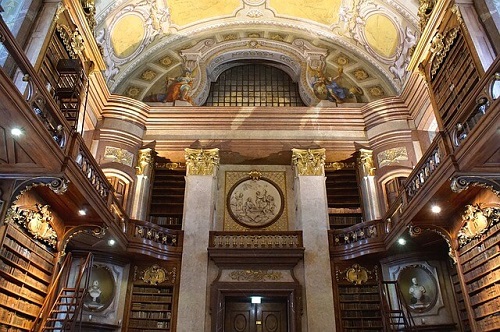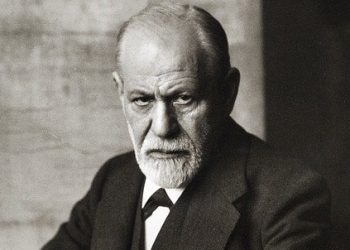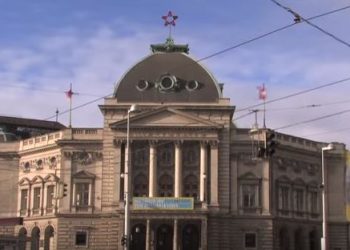The library’s total collection numbers around 7 million items, but “only” about 200,000 ancient books are displayed in the main State Hall. The hall is spacious, about 80 meters long with a ceiling height of 20 meters. Along all its walls, bookshelves are arranged, reaching almost to the ceiling, and numerous statues and murals adorn it beautifully. The oldest book in the library dates back to 1368.
Don’t be surprised by the long queue at the ticket counters; many visitors flock to the State Hall to witness the extraordinary structure, and it is certainly a sight you usually only see in movies!
Besides the main State Hall, the National Library complex includes several other museums: the Literature Museum, the Globe Museum, the Papyrus Museum, and the Esperanto Museum. These are small museums, but they have very interesting exhibits.
The Story of the National Library and its Collection of Ancient Books
The Austrian National Library was originally the Imperial Library of the Austrian dukes and emperors and was called the Imperial Court Library (Kaiserliche Hofbibliothek). It began operating within the Hofburg Palace as early as the Middle Ages.
The first books of the library were part of the rare book collection of the Austrian Duke Albrecht III and were transferred to it in the mid-14th century.
Over the years, as a result of marriages between members of the Habsburg family and royalty from other countries, the book collection grew and was supplemented with ancient books from countries like France and Italy. Due to the large size of the book collection, they were stored in several places – some were in Vienna, some in the city of Wiener Neustadt (a city about 60 kilometers south of Vienna), and some were in Innsbruck. The ancient collection included not only books but also ancient globes and atlases.
In 1722, Emperor Charles VI ordered the construction of a permanent building for the library within the palace grounds. The magnificent structure was built by Joseph Emanuel Fischer von Erlach based on the plans of his father, Johann Bernhard Fischer von Erlach. After its completion, the new building became the permanent home of the library, and about 200,000 books were stored in it. The grand building drew criticism from the city’s residents, who claimed that the library served to display the wealth of the Habsburgs and was not used for knowledge and learning at all.
During the Nazi regime, the library was managed by an enthusiastic supporter of the regime, Paul Heigl. Under Heigl’s management, the library systematically dispossessed Jews of ancient books they owned. No less than 25,000 books were stolen from their owners under Nazi control. Although some of the Jewish books were returned to their rightful owners in the years after the war, a large portion of them still remains in the library today.
After the establishment of the Republic of Austria, the library’s name was changed to the Austrian National Library.
The Collections in the National Library
One of the library’s main tasks is to collect and preserve all publications made in Austria (including electronic copies). In total, there are about 7 million items in the National Library’s collection, not all of which are necessarily books.
The library’s ancient books date back to the 14th century, but the collection also includes writings from as early as the 4th century CE. The variety in the ancient collection includes writings from almost every culture that knew how to put its ideas on paper. One of the manuscripts, from the 6th century CE, called the Vienna Dioscurides, is included in UNESCO’s Memory of the World Register. The most comprehensive collections include the books of Prince Eugene of Savoy and also the writings of Martin Luther from the Reformation period.
In addition, the National Library has an exceptional collection of maps and globes from the 16th century, some of which are displayed in the unique Globe Museum. Another, no less important collection is the Papyrus Collection, which includes 180,000 items. Some of the items date back to the 15th century BCE! This is the largest papyrus collection in the world.
The State Hall (Prunksaal)
This is the largest and most impressive building of the library, built in the mid-18th century. It is designed in the Baroque style and is beautifully decorated with sculptures and murals. The hall itself is 80 meters long, and its high ceiling rises to a height of 20 meters. Inside the building, 200,000 ancient books are stored on countless shelves that reach almost to the ceiling. It may seem that the books are not arranged in any particular order, but in fact, they are divided into two: one side related to war, and the other to peace.

Although the hall is very crowded with books, it is also designed in an extraordinary way. The ceiling of the building is adorned with magnificent murals by the artist Daniel Gran, which also reflect the division of the collection into war and peace. The ceiling painting depicts the figure of Emperor Charles VI with Hercules and Apollo holding him, surrounded by a variety of objects symbolizing the virtues and wealth of the Habsburgs.
Throughout the hall, there are 16 large marble statues of the Habsburg emperors from Austria and Spain, with the statue of Charles VI from 1735 standing in the center. In addition to the statues, there are also 4 ancient Venetian globes with a diameter of one meter!
You can see the magnificent ceiling painting here.
The Exhibition in the State Hall
In the past year, there has been a permanent exhibition to mark the 650th anniversary of the National Library (based on its oldest book, written in 1368).
The ancient book, once owned by Duke Albrecht III, is the starting point for the journey of the Austrian National Library. As part of this exhibition, ancient writings, papyri, and prints from the early days of printing, rare music scores, maps, pictures, and works of art are displayed.
All these lead visitors through the library’s long history, from the Emperor’s house, through the period of the First Austrian Republic, to the days of Nazi rule and the restitution of stolen books.
Guided Tours
The National Library offers visitors guided tours of the building and its exhibitions. On weekends, guided tours are held in English. You can book tickets online and join a tour. The tour cost also includes the entrance ticket.
- Tour duration: 45 minutes
- Cost: Adult – €16, Child – €3.30
- English tour times: Saturdays at 3:00 PM
- Book tickets for a guided tour in English
It is also possible to arrange private tours in English for groups of 10 or more. Please contact by email: kulturvermittlung@onb.ac.at.
You can also take a virtual tour of the museum.
Additional Essential Information for Visiting the National Library
The National Library building is located in the city center, in the back part of the Hofburg Palace. The building is next to Josefsplatz, in the center of which stands an impressive statue of Franz Joseph, so it’s hard to miss.
Opening Hours of the Main Hall of the National Library:
- Tuesday and Wednesday: from 10:00 AM to 6:00 PM.
- Thursday: from 10:00 AM to 9:00 PM.
- Friday to Sunday: from 10:00 AM to 6:00 PM.
- Monday: Closed
Entrance Ticket Cost (without a guided tour):
- Adult: €11
- Children under 19 enter for free (must be accompanied by at least one adult)
- Holders of the Vienna Pass enter for free
- There are discounted tickets for students and seniors. They can be purchased at the ticket office only upon presentation of an ID.
- Tickets can be purchased online.
Address
Josefsplatz 1, 1015, Vienna
How to get to the National Library?
You can reach the State Hall from two subway stations. The closest station is Stephansplatz, served by the red line U1 or the orange line U3. The walking distance from there is about 5 minutes.
Another option is to go to the Museumsquartier station using the purple line U2. From there, the walking distance is 10 minutes.
Map:
In the National Library complex, there are 4 other small museums with special and particularly impressive exhibitions.
- Literature Museum The museum presents the world of Austrian literature from the 18th century to the present day. It deals with the lives and works of various Austrian writers and teaches about the uniqueness of their works. The museum is located on Johannesgasse, about a 7-minute walk from the main State Hall.
- Globe Museum An impressive display of over 250 globes and various measuring instruments related to the world of globes. You can see how the world was depicted in previous centuries and what globes looked like in the past. The display includes very large globes and even one with Hebrew letters. The museum is located on Herrengasse, about a 5-minute walk from the main State Hall and in the same building as the Esperanto Museum.
- Papyrus Museum This museum is relatively small but packed with rare historical exhibits. About 300 writings and objects are displayed as part of the museum. You can see how the ancients wrote on papyrus papers and learn about ancient cultures. This is a museum of rare historical wealth, in everything related to the world of papyri. The entrance to the museum is from Heroes’ Square (Heldenplatz), about a 3-minute walk from the main State Hall.
- Esperanto Museum This museum presents the history and development of the Esperanto language, whose founders hoped it would become an international language. The museum has cute interactive displays that allow visitors to better understand the basis of the language and its development process. The museum is located on Herrengasse, about a 5-minute walk from the main State Hall and in the same building as the Globe Museum.
Read more extensive information about the 4 museums of the Austrian National Library.


















